MSR brought out their Windburned stove last year. It was originally called the Windboiler. It is their entry into the market pretty much started by the Jetboil. The idea is simple, a stove that is self contained and will boil water / heat up food, with ruthless efficiency. What the Windburner does that its competitors dont is complete this task even strong winds without the need for any wind break.
However as well as discussing this stove I want to give my thoughts on how this class of stove can replace some existing items I carry. As you can guess from the title these are vacuum flasks and water filters but you can also add water to that, for me at least.
So the Windburner Stove.
The manufacturers page for the stove is here http://www.cascadedesigns.com/msr/stoves/stove-systems/windburner/product All the specs are there and on the box so I wont cover them in any detail. The stove arrives like this.
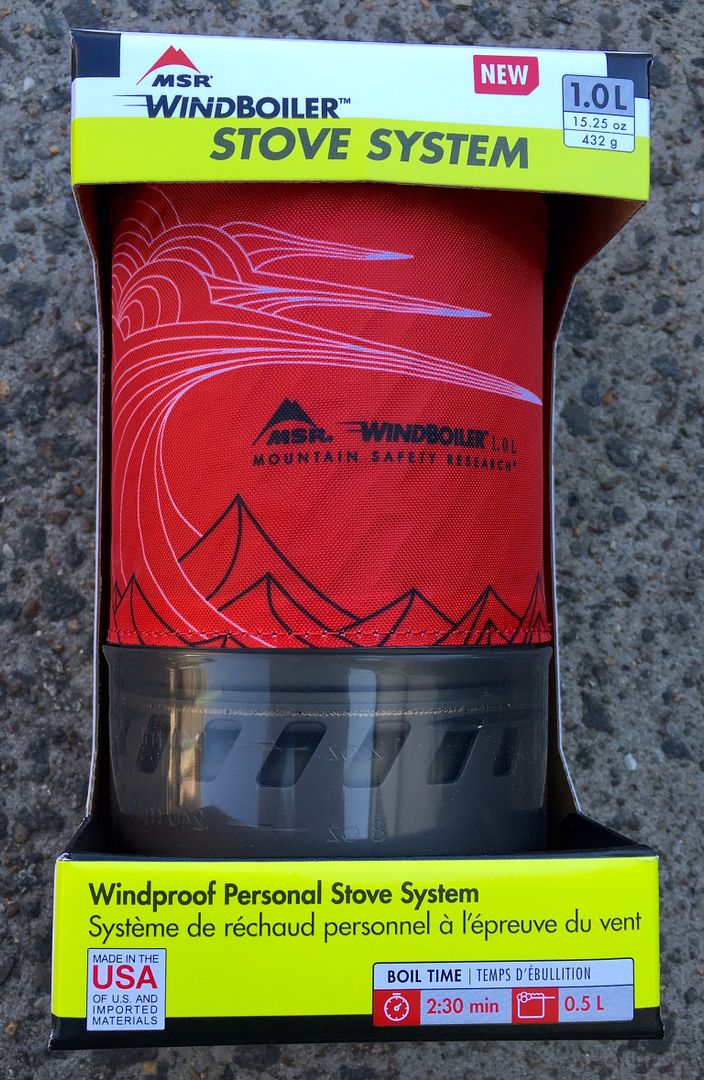

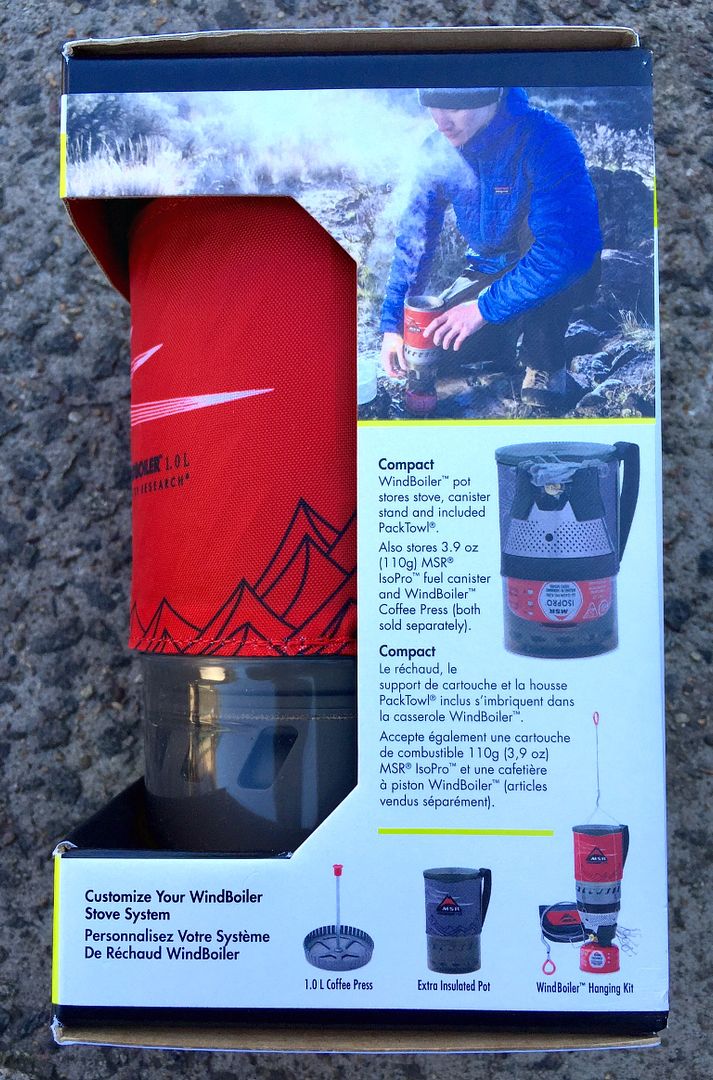
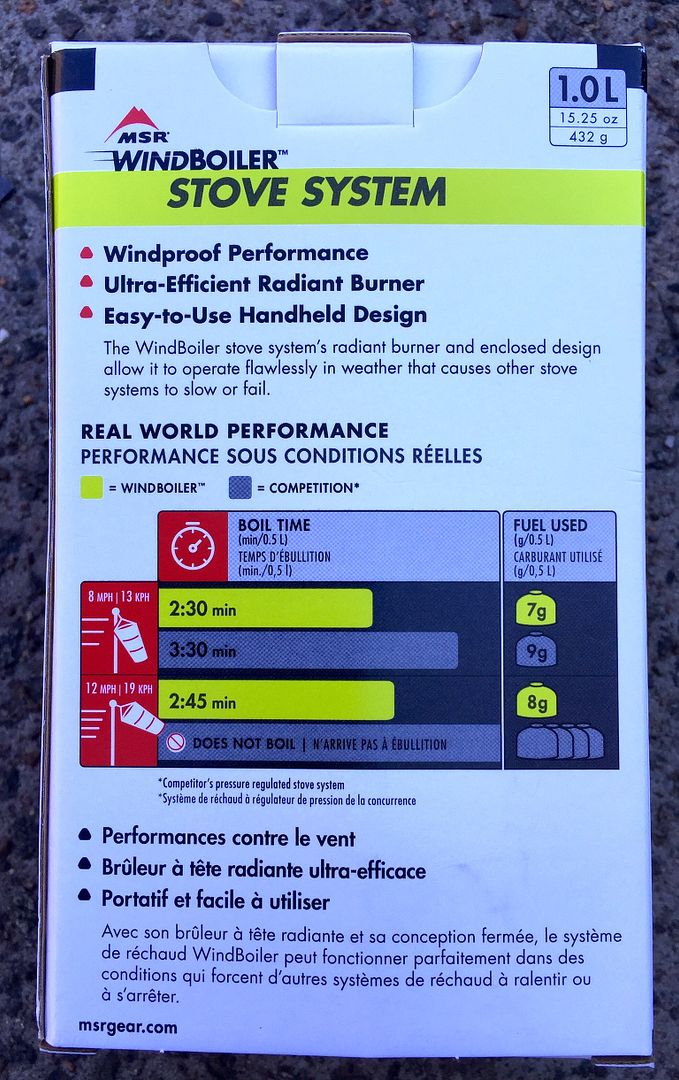
In the hand the complete set up including a 100g gas canister look like this.
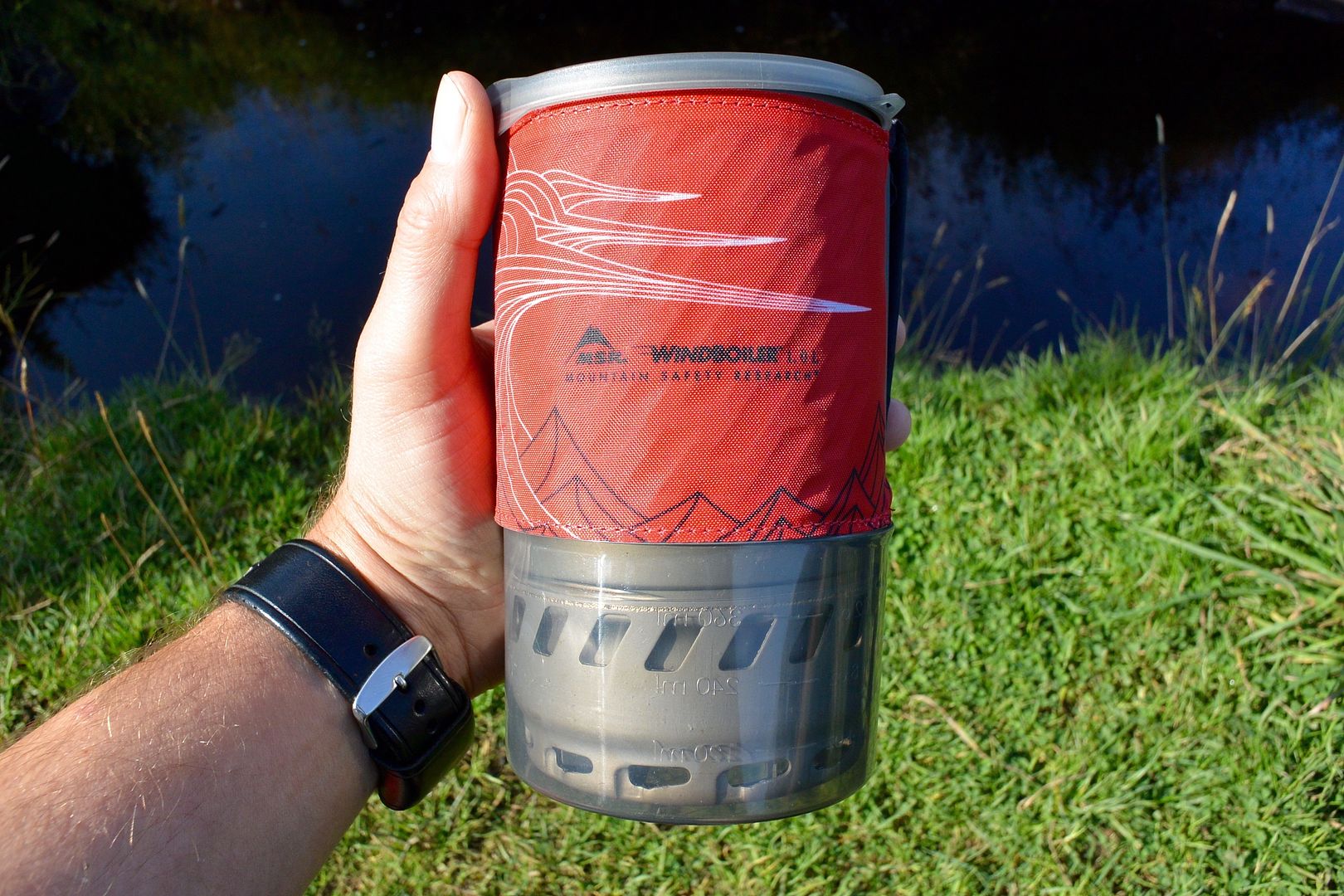
The stove will also work with 220g gas cartridges, however, these will not fit inside the cup for storage. I keep the complete set up in a small bag which either holds the stove as above plus, sweetners, 2 in 1 coffee sachets, a spoon and some cup a soups. If I am using the 220g canister then the brew kit goes in the cup and the canister sits on top in the bag. Still a pretty compact set up.
The stove proudly markets itself as the 1.0l system and this is the capacity of the mug when filled, however be aware you can only boil 0.6l at a time as you need space at the top for safety. However, MSR are bringing out a bigger 1.8l pot for the stove to make it more suitable for more than one person and will also fit the 220g gas canister inside it along with the burner etc. There also plans for a skillet for the stove (frying pan to you and me). These should be available next year (2016).
Popping the lid off of the cup shows all the parts of the system crammed inside.

There is a lot in there.
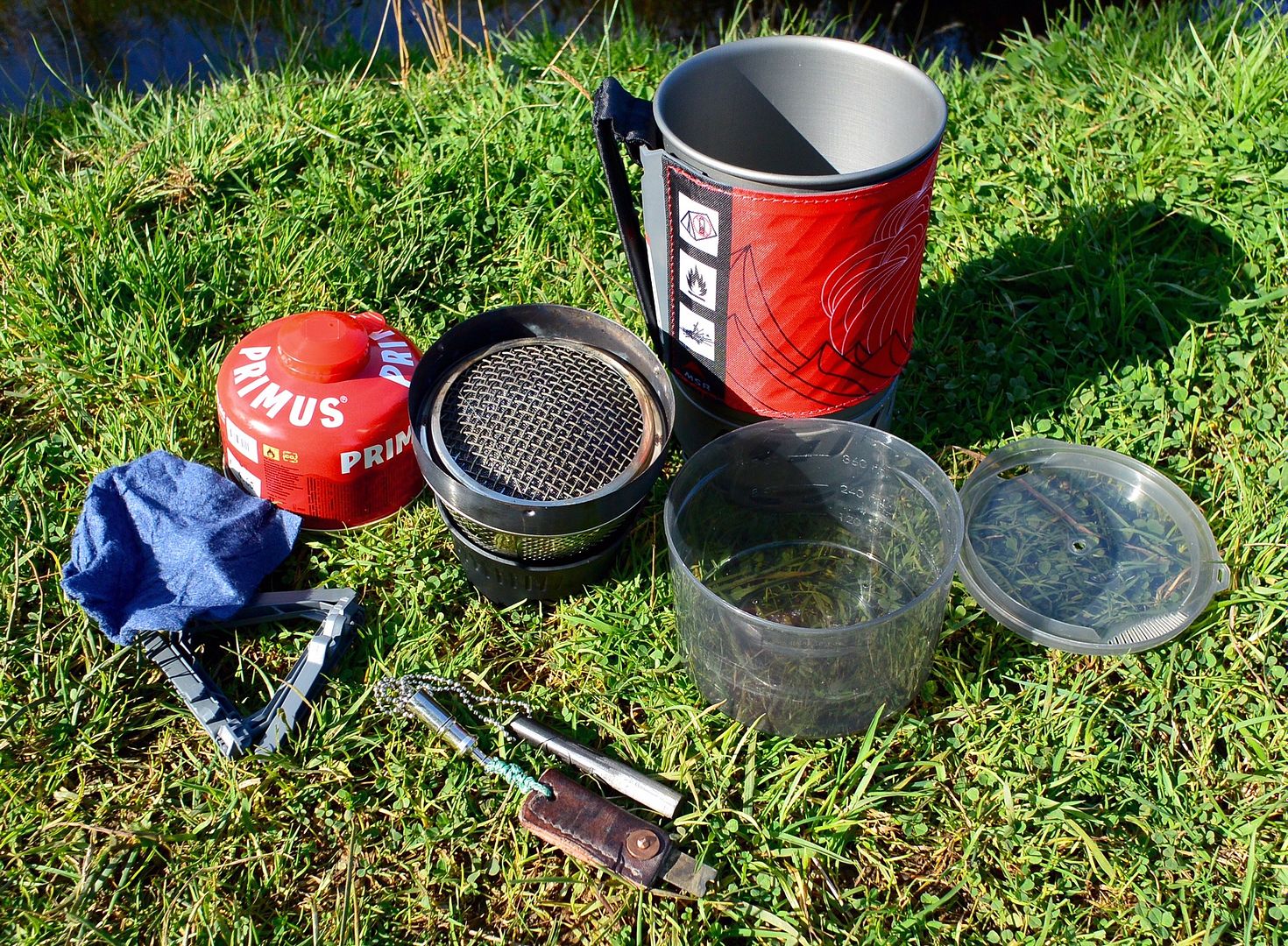
Starting from the left we have a small towel, a stand that attaches to either size of gas canister, the 100g gas canister, the stove burner assembly, the cup / pot with built in heat exchanger on the bottom, the lid for the cup / pot, a plastic bowl that fits over the bottom of the cup / pot and in front of it all a firesteel and scraper.
The firesteel does not come with the stove. you need to provide your own or matches. I do not know why the stove does not have a piezo ignition system. It seems a glaring omission from this complete system but I assume there is some technical reason behind it. Once you add a firesteel to the set you are pretty much covered for lighting the stove in any conditions for the foreseeable future so not a big issue but a strange omission in my eyes anyway.
The underside of the cup shows the heat exchanger and the cowling that makes this stove so efficient even in the wind.
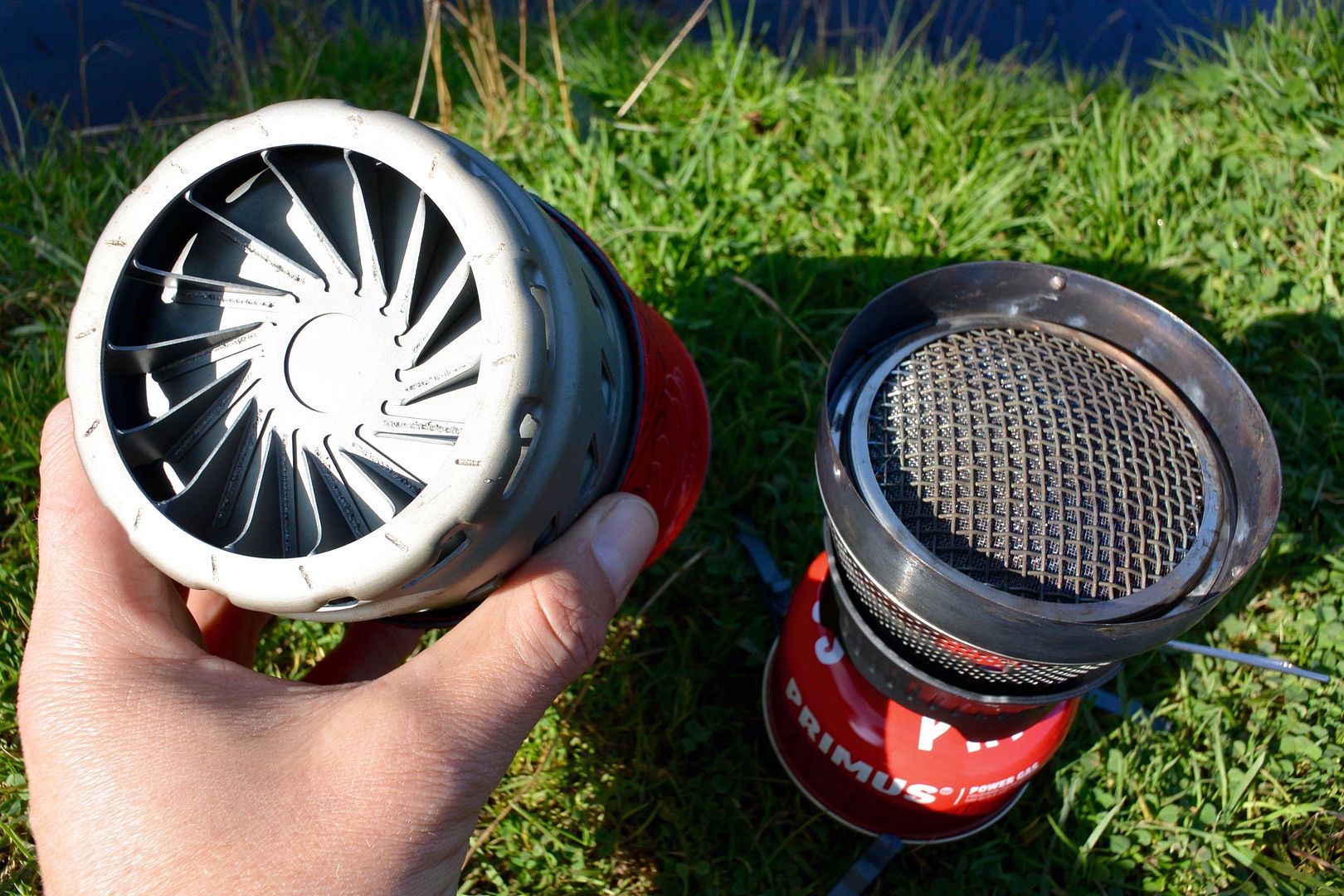
The efficiency is the main selling points of these stoves so lets talk about that. There are two parts of this efficiency. Time and fuel. So put water in the cup and light the stove.
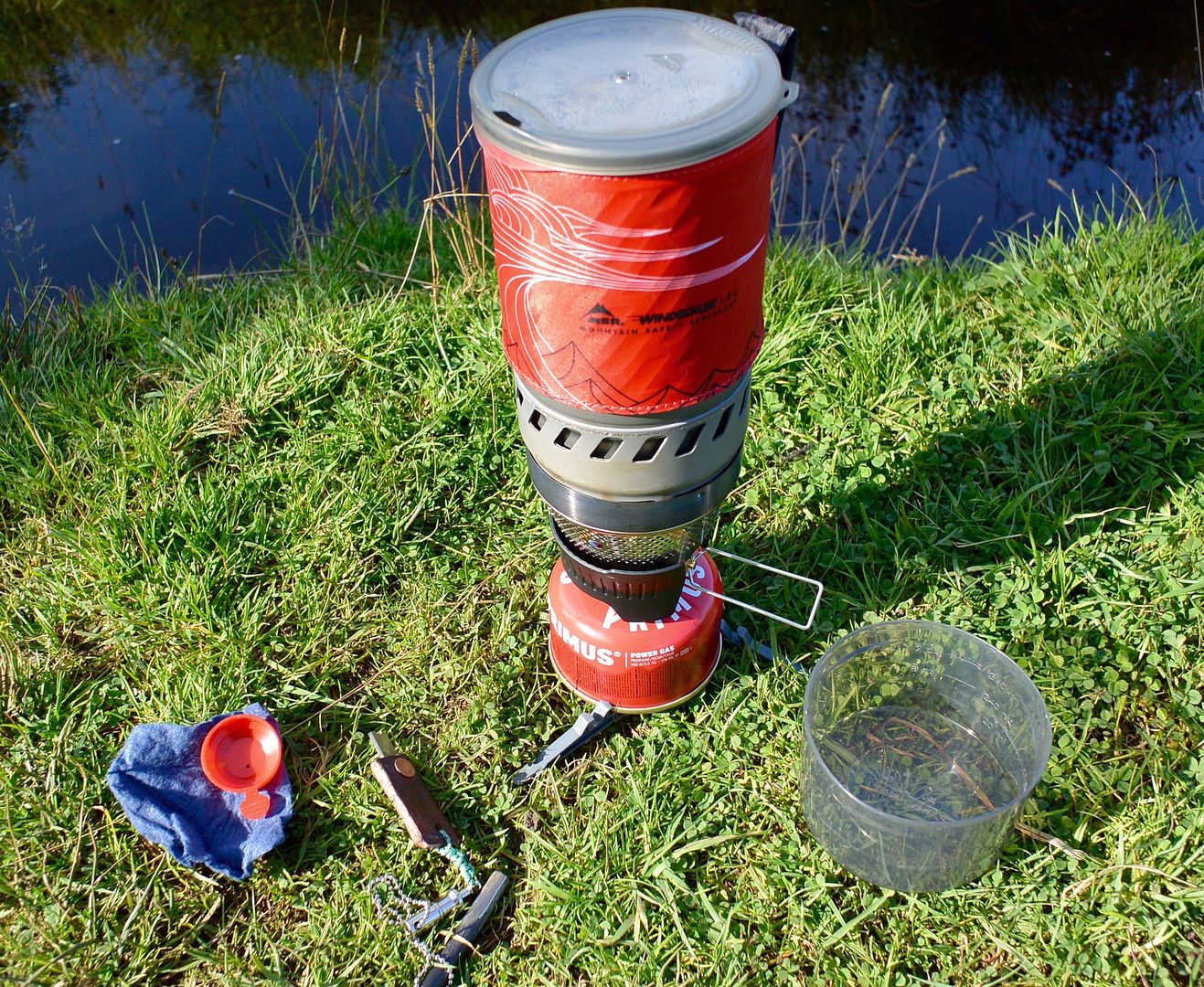
And in an absurdly short time you are looking at this.
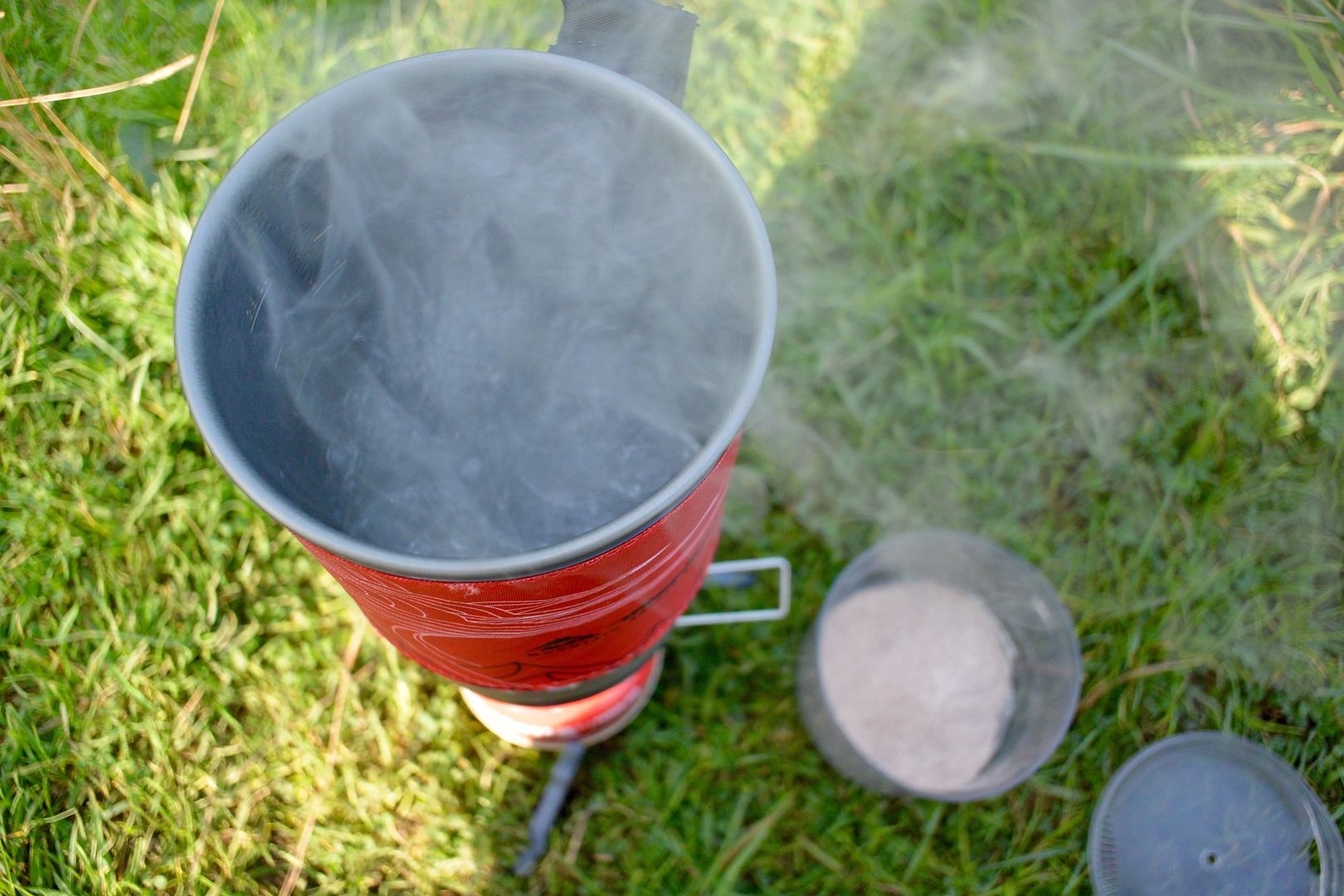
Of course the actual time will depend on the quantity of water the air temperature, altitude, wind speed etc etc. The packaging quotes times of between 2 minutes 30 seconds to 2 minutes 45 seconds for 0.5 litre of water using between 7 and 8 grammes of fuel. I tested on a number of occasions boiling 0.6 litre of water and the boil was consistently under the 3 minute mark and used about 8 grammes of fuel. Due to some sort of magic on MSRs side there does not seem to be any drop in efficiency as the canister nears empty. In my experience the stove seemed to maintain its full power pretty much right up till the canister ran out.
Boiling enough water for a single brew was so quick as to be almost inconvenient. The water is boiling before you can sort out the coffee etc.
Allowing for waste and poor conditions the above equates to at least 6 litres of boiled (purified) water from the 100g canister and over 13 litres for the 220 gramme cartridge. Either is enough for a couple of nights use. Annoyingly the 100g carried costs about £4.00 at the moment and the 220g cartridge can be got for £5.00. Clearly the 220g is far better value. That said for the extra couple of quid the 100g cartridge does make for a very compact set up. The 220g still makes a compact package just not quite as neat.
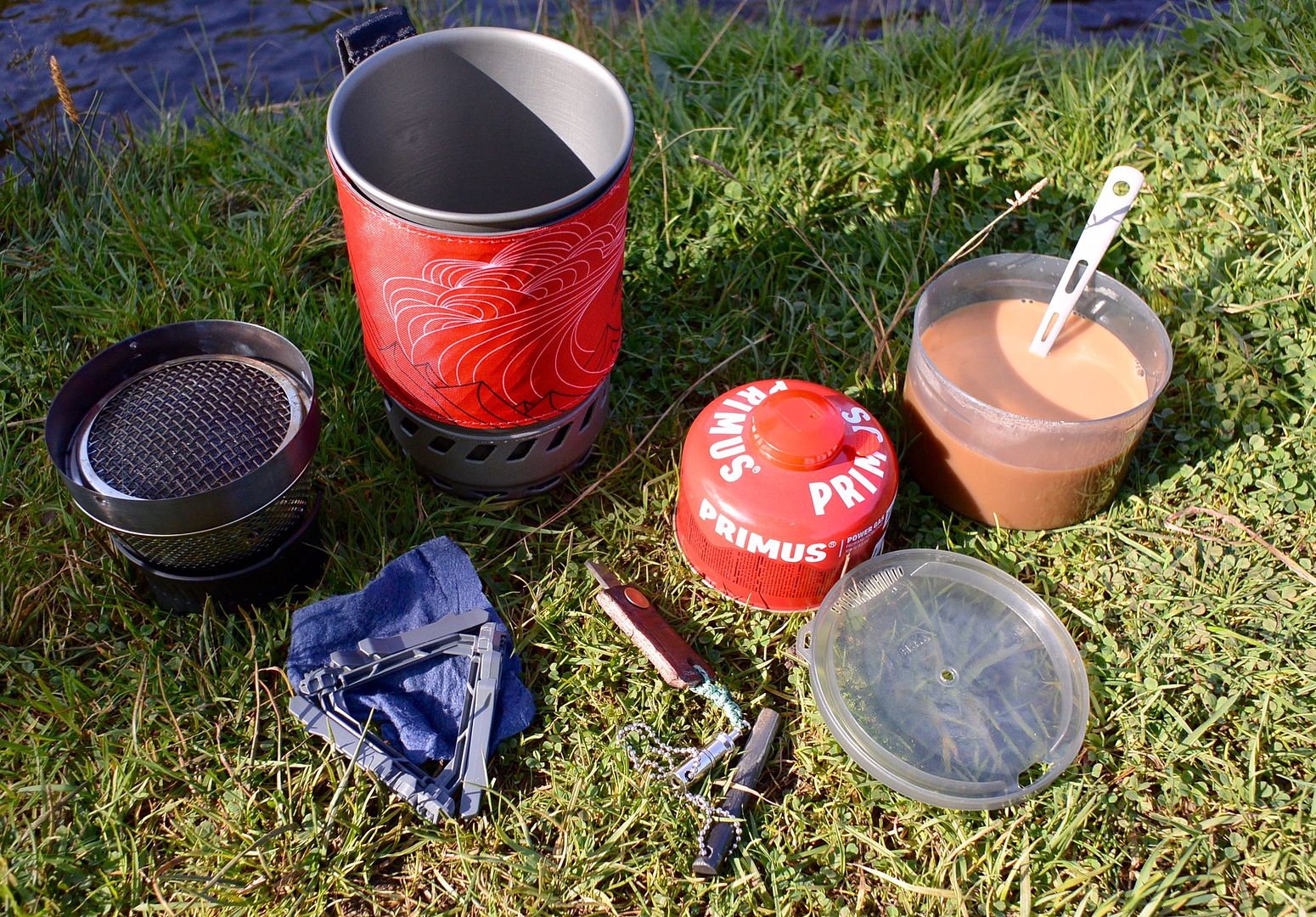
So for boiling water the stove is really good. However this efficiency does come with some problems. I could not simmer with this stove. because the heat exchanger is so efficient and the cup well insulated the stove could not be turned down low enough to simmer without going out. There are three solutions to this that I came up with. Each has its own plus and minus points. First just get the food to the boil, turn the stove off, then relight it after 5 minutes, bring it back to the boil (will be seconds) then stir and turn the stove off again. Repeat until the food is cooked. Because the pot locks to the burner and you need to light using the firesteel or matches this is a bit of a pain.
The next two solutions are really variations on a theme. The one that suits you will depend on how weight conscious you are. My preferred solution is the heavyweight solution although still a big weight saver as I will discuss later. This solution is a food flask. So get the food to boiling then put it in the flask. Leave till ready and eat. Or wait longer till it suits you. It was a SotP member who suggested this and it is luxury. At night I boil enough water for a night time cuppa and the rest goes in a flask with two packets of Oats to Simple. Give it a shake and leave. then whenever I wake up in the morning I just need to open the flask to have hot oats ready on tap. After breakfast I wash out the flask and fill it with supernoodles or pasta or a rice dish and fill with boiling water and seal it all up. Whenever I decide to stop for lunch I have a hot meal ready.
Words really cannot describe the joy of waking in your bedroll at the side of the loch just as the sun is starting to come up. Its been a clear night with a nip in the air. The stars fade as the sun brightens the sky. Without even getting out of your sleeping bag you open the flask and tuck into hot sweat porridge as you watch the world come to life. Works in hammocks too . In fairness the stove is so compact and easy to use you could cook porridge in it without getting out your sleeping bag but thats still like work when you first wake
. In fairness the stove is so compact and easy to use you could cook porridge in it without getting out your sleeping bag but thats still like work when you first wake 
The lightweight solution is to make a pot cosy for the windburner pot. This works much like the flask but is not transportable. The pot just sits in the cosy until the food is ready to eat. You might get the breakfast plan to work but you are not going to have the pot and cosy in your pack while you carry it from breakfast till lunch.
I promised to discuss how this stove could replace a flask but have just recommended a food flask to go with the stove. The vacuum flask this stove replaces is the one with hot water. In winter I almost always take a flask with hot water in it with me. This is to give me access to a hot drink quickly should I get chilled either just from the cold or from taking a swim. A full 1 litre flask is way heavier than the Windburner. Also the stove gives me at least 6 times as much boiling water on tap. The stove would provide some heat while boiling the water as well as hot water to drink.
Similarly anywhere I go, especially when paddling, there is a lot of water about. All it needs to be drinkable water is a quick boil. And as we have discussed the windburner excels at a quick boil. Because it will boil even when in a strong wind there is really very few circumstances where I could imagine it not working. And in none of these situations would any of my current options work for me either.
I have actually stopped carrying a water filter with me on paddling trips anyway, however I make a point of always having at least one litre of drinkable water, usually two. These are topped up from boiled water at every meal or brew stop. With the windburner I dont feel the need to have as much or even any water with me. I can quickly boil water even while still in the canoe and on the water, although i feel sure MSR would tell me this is not recommended or condoned
So in summary I really like this stove. It ticks so many boxes for me I am actually annoyed that I have not had this type of stove before now. That said if you are a chef type this stove may not suit you due to the lack of easy simmering. If you want a stove for a bigger group then you may want to wait for the 1.8 litre pot or you can dive in now and buy the bigger pot when it becomes available.
So in a sentence. I highly recommend this stove.
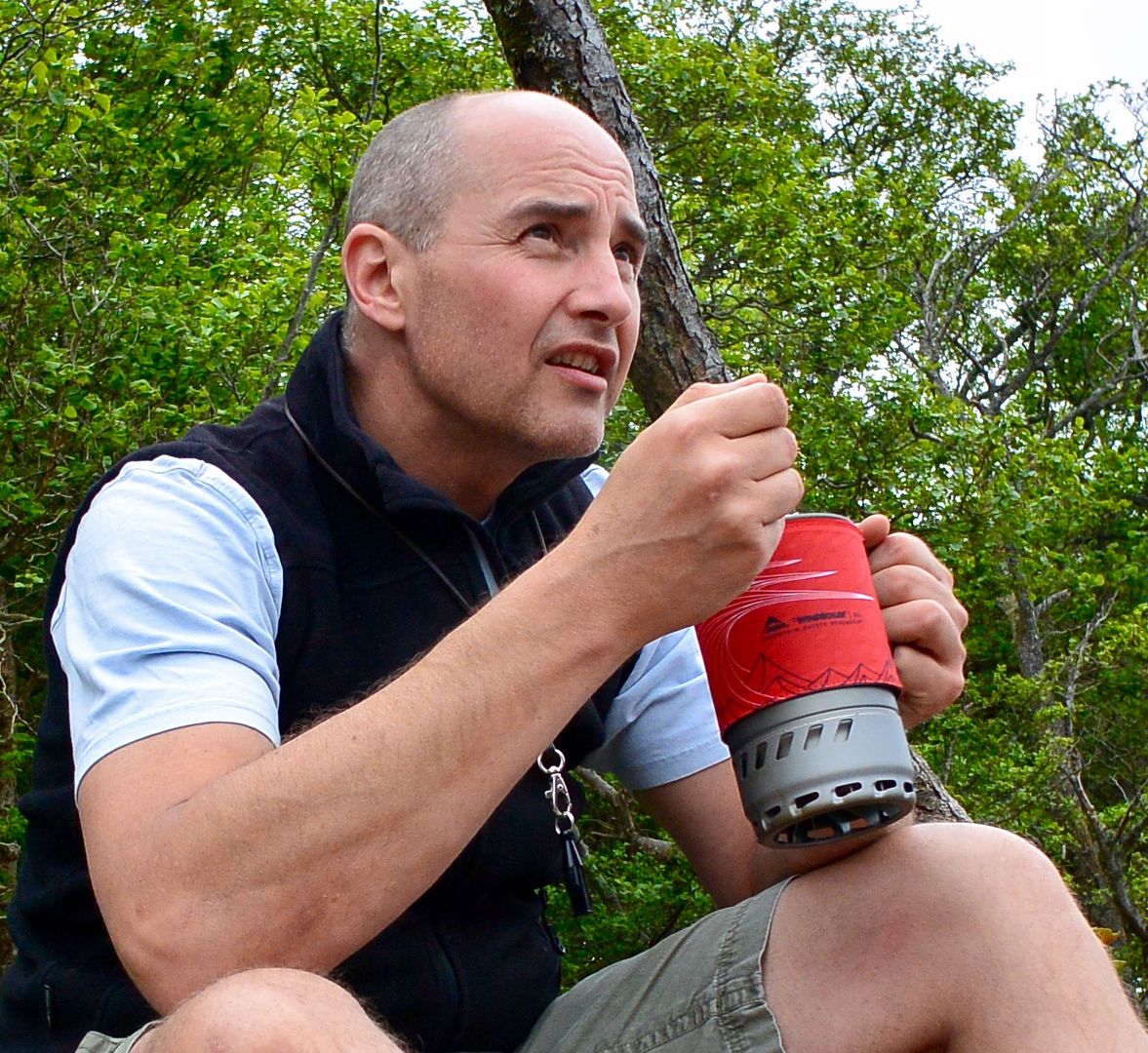
However as well as discussing this stove I want to give my thoughts on how this class of stove can replace some existing items I carry. As you can guess from the title these are vacuum flasks and water filters but you can also add water to that, for me at least.
So the Windburner Stove.
The manufacturers page for the stove is here http://www.cascadedesigns.com/msr/stoves/stove-systems/windburner/product All the specs are there and on the box so I wont cover them in any detail. The stove arrives like this.




In the hand the complete set up including a 100g gas canister look like this.

The stove will also work with 220g gas cartridges, however, these will not fit inside the cup for storage. I keep the complete set up in a small bag which either holds the stove as above plus, sweetners, 2 in 1 coffee sachets, a spoon and some cup a soups. If I am using the 220g canister then the brew kit goes in the cup and the canister sits on top in the bag. Still a pretty compact set up.
The stove proudly markets itself as the 1.0l system and this is the capacity of the mug when filled, however be aware you can only boil 0.6l at a time as you need space at the top for safety. However, MSR are bringing out a bigger 1.8l pot for the stove to make it more suitable for more than one person and will also fit the 220g gas canister inside it along with the burner etc. There also plans for a skillet for the stove (frying pan to you and me). These should be available next year (2016).
Popping the lid off of the cup shows all the parts of the system crammed inside.

There is a lot in there.

Starting from the left we have a small towel, a stand that attaches to either size of gas canister, the 100g gas canister, the stove burner assembly, the cup / pot with built in heat exchanger on the bottom, the lid for the cup / pot, a plastic bowl that fits over the bottom of the cup / pot and in front of it all a firesteel and scraper.
The firesteel does not come with the stove. you need to provide your own or matches. I do not know why the stove does not have a piezo ignition system. It seems a glaring omission from this complete system but I assume there is some technical reason behind it. Once you add a firesteel to the set you are pretty much covered for lighting the stove in any conditions for the foreseeable future so not a big issue but a strange omission in my eyes anyway.
The underside of the cup shows the heat exchanger and the cowling that makes this stove so efficient even in the wind.

The efficiency is the main selling points of these stoves so lets talk about that. There are two parts of this efficiency. Time and fuel. So put water in the cup and light the stove.

And in an absurdly short time you are looking at this.

Of course the actual time will depend on the quantity of water the air temperature, altitude, wind speed etc etc. The packaging quotes times of between 2 minutes 30 seconds to 2 minutes 45 seconds for 0.5 litre of water using between 7 and 8 grammes of fuel. I tested on a number of occasions boiling 0.6 litre of water and the boil was consistently under the 3 minute mark and used about 8 grammes of fuel. Due to some sort of magic on MSRs side there does not seem to be any drop in efficiency as the canister nears empty. In my experience the stove seemed to maintain its full power pretty much right up till the canister ran out.
Boiling enough water for a single brew was so quick as to be almost inconvenient. The water is boiling before you can sort out the coffee etc.
Allowing for waste and poor conditions the above equates to at least 6 litres of boiled (purified) water from the 100g canister and over 13 litres for the 220 gramme cartridge. Either is enough for a couple of nights use. Annoyingly the 100g carried costs about £4.00 at the moment and the 220g cartridge can be got for £5.00. Clearly the 220g is far better value. That said for the extra couple of quid the 100g cartridge does make for a very compact set up. The 220g still makes a compact package just not quite as neat.

So for boiling water the stove is really good. However this efficiency does come with some problems. I could not simmer with this stove. because the heat exchanger is so efficient and the cup well insulated the stove could not be turned down low enough to simmer without going out. There are three solutions to this that I came up with. Each has its own plus and minus points. First just get the food to the boil, turn the stove off, then relight it after 5 minutes, bring it back to the boil (will be seconds) then stir and turn the stove off again. Repeat until the food is cooked. Because the pot locks to the burner and you need to light using the firesteel or matches this is a bit of a pain.
The next two solutions are really variations on a theme. The one that suits you will depend on how weight conscious you are. My preferred solution is the heavyweight solution although still a big weight saver as I will discuss later. This solution is a food flask. So get the food to boiling then put it in the flask. Leave till ready and eat. Or wait longer till it suits you. It was a SotP member who suggested this and it is luxury. At night I boil enough water for a night time cuppa and the rest goes in a flask with two packets of Oats to Simple. Give it a shake and leave. then whenever I wake up in the morning I just need to open the flask to have hot oats ready on tap. After breakfast I wash out the flask and fill it with supernoodles or pasta or a rice dish and fill with boiling water and seal it all up. Whenever I decide to stop for lunch I have a hot meal ready.
Words really cannot describe the joy of waking in your bedroll at the side of the loch just as the sun is starting to come up. Its been a clear night with a nip in the air. The stars fade as the sun brightens the sky. Without even getting out of your sleeping bag you open the flask and tuck into hot sweat porridge as you watch the world come to life. Works in hammocks too
The lightweight solution is to make a pot cosy for the windburner pot. This works much like the flask but is not transportable. The pot just sits in the cosy until the food is ready to eat. You might get the breakfast plan to work but you are not going to have the pot and cosy in your pack while you carry it from breakfast till lunch.
I promised to discuss how this stove could replace a flask but have just recommended a food flask to go with the stove. The vacuum flask this stove replaces is the one with hot water. In winter I almost always take a flask with hot water in it with me. This is to give me access to a hot drink quickly should I get chilled either just from the cold or from taking a swim. A full 1 litre flask is way heavier than the Windburner. Also the stove gives me at least 6 times as much boiling water on tap. The stove would provide some heat while boiling the water as well as hot water to drink.
Similarly anywhere I go, especially when paddling, there is a lot of water about. All it needs to be drinkable water is a quick boil. And as we have discussed the windburner excels at a quick boil. Because it will boil even when in a strong wind there is really very few circumstances where I could imagine it not working. And in none of these situations would any of my current options work for me either.
I have actually stopped carrying a water filter with me on paddling trips anyway, however I make a point of always having at least one litre of drinkable water, usually two. These are topped up from boiled water at every meal or brew stop. With the windburner I dont feel the need to have as much or even any water with me. I can quickly boil water even while still in the canoe and on the water, although i feel sure MSR would tell me this is not recommended or condoned
So in summary I really like this stove. It ticks so many boxes for me I am actually annoyed that I have not had this type of stove before now. That said if you are a chef type this stove may not suit you due to the lack of easy simmering. If you want a stove for a bigger group then you may want to wait for the 1.8 litre pot or you can dive in now and buy the bigger pot when it becomes available.
So in a sentence. I highly recommend this stove.


